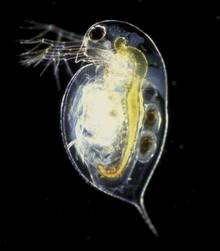

|
m ISBNs (Build KE)
|
No edit summary
|
||
| Line 17: | Line 17: | ||
}} |
}} |
||
ovh |
|||
'''Cladocera''' is an [[order (biology)|order]] of small [[crustacean]]s commonly called '''water fleas'''. Around 620 species have been recognised so far, with many more [[undescribed species|undescribed]]. They are ubiquitous in inland aquatic habitats, but rare in the oceans. Most are {{convert|0.2|-|6.0|mm|abbr=on}} long, with a down-turned head, and a carapace covering the apparently unsegmented thorax and abdomen. There is a single median [[compound eye]]. Most species show cyclical [[parthenogenesis]], where [[asexual reproduction]] is occasionally supplemented by [[sexual reproduction]], which produces resting eggs that allow the species to survive harsh conditions and disperse to distant habitats. |
|||
|
|||
==Description== |
|||
[[File:Leptodora.png|thumb|left|''[[Leptodora kindtii]]'' is an unusually large cladoceran, at up to 18 mm long.]] |
|||
They are mostly {{convert|0.2|-|6.0|mm|3}} long, with the exception of ''[[Leptodora]]'', which can be up to {{convert|18|mm|abbr=on}} long.<ref name="Forró"/> The body is not obviously segmented and bears a folded [[carapace]] which covers the [[thorax]] and [[abdomen]].<ref name="Pennak"/> |
|||
The head is angled downwards, and may be separated from the rest of the body by a "cervical sinus" or notch.<ref name="Pennak"/> It bears a single black [[compound eye]], located on the animal's midline, in all but two genera, and there is often a single [[ocellus]].<ref name="Belk"/> The head also bears two pairs of [[antenna (biology)|antennae]] – the first antennae are small, unsegmented appendages, while the second antennae are large, segmented and branched, with powerful muscles.<ref name="Pennak"/> The first antennae bear olfactory [[seta]]e, while the second are used for swimming by most species.<ref name="Belk"/> The pattern of setae on the second antennae is useful for identification<!--; ''Daphnia''-->.<ref name="Pennak"/> The part of the head which projects in front of the first antennae is known as the [[rostrum (anatomy)|rostrum]] or "beak".<ref name="Pennak"/> |
|||
The [[arthropod mouthparts|mouthparts]] are small, and consist of an unpaired labrum, a pair of mandibles, a pair of maxillae, and an unpaired labium.<ref name="Pennak"/> They are used to eat "organic detritus of all kinds" and [[bacteria]].<ref name="Pennak"/> |
The [[arthropod mouthparts|mouthparts]] are small, and consist of an unpaired labrum, a pair of mandibles, a pair of maxillae, and an unpaired labium.<ref name="Pennak"/> They are used to eat "organic detritus of all kinds" and [[bacteria]].<ref name="Pennak"/> |
||
| Cladocera | |
|---|---|

| |
| Daphnia pulex | |
| Scientific classification | |
| Kingdom: | |
| Phylum: | |
| Subphylum: | |
| Class: | |
| Subclass: | |
| Order: | Cladocera Latreille, 1829 |
| Suborders | |
ovh
The mouthparts are small, and consist of an unpaired labrum, a pair of mandibles, a pair of maxillae, and an unpaired labium.[1] They are used to eat "organic detritus of all kinds" and bacteria.[1]
The thorax bears five or six pairs of lobed, leaf-like appendages, each with numerous hairs or setae.[1] Carbon dioxide is lost, and oxygen taken up, through the body surface.[1]
With the exception of a few purely asexual species, the life cycle of cladocerans is dominated by asexual reproduction, with occasional periods of sexual reproduction; this is known as cyclical parthenogenesis. The system evolved in the Permian, at the same time that the Cladocera arose.[2] When conditions are favourable, reproduction occurs by parthenogenesis for several generations, producing only female clones. As the conditions deteriorate, males are produced, and sexual reproduction occurs. This results in the production of long-lasting dormant eggs. These ephippial eggs can be transported over land by wind, and hatch when they reach favourable conditions, allowing many species to have very wide – even cosmopolitan – distributions.[1]

Most cladoceran species live in fresh water and other inland water bodies, with only eight species being truly neritic (oceanic).[3] The marine species are all in the family Podonidae, except for the genus Penilia.[3]

The order Cladocera is included in the class Branchiopoda, and forms a monophyletic group, which is currently divided into four suborders. Around 620 species have been described, but many more species remain undescribed.[4] The genus Daphnia alone contains around 150 species.[2]
The following families are recognised:[5]
Order Cladocera Latreille, 1829
The word "Cladocera" derives via New Latin from the Ancient Greek κλάδος (kládos, "branch") and κέρας (kéras, "horn").[8]
{{cite journal}}: |chapter= ignored (help)CS1 maint: multiple names: authors list (link) doi:10.1007/978-1-4020-8259-7_19
|
Families of class Branchiopoda
| ||
|---|---|---|
| ||
| Anostraca |
| |
| Notostraca |
| |
| Laevicaudata |
| |
| Spinicaudata |
| |
| Cyclestherida |
| |
| Cladocera |
| |